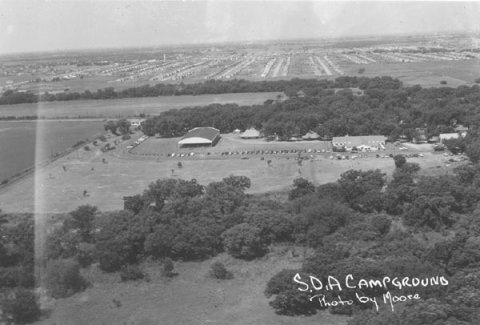Description:

It began as a 160 acre wheat field, three miles east of Oklahoma City and two miles west of Midwest City. In 1946, two families occupied the area of what is now called Del City, Oklahoma. Today, more than 22,000 people call the place home, including two-time Olympic gold medalist, wrestler John Smith.
George Irvin Epperly purchased the property, adjacent to a main highway, with the dream of building a new city between Oklahoma City and Midwest City. Early in the planning stages, Epperly pitted his four daughters against one another in a contest. He told them he would pay $100 to the one who came up with the best name for his fledgling city. “They came up with a lot of them,” he said. “But I threw them all out and named it after my oldest daughter, Delaphene.” Neither she nor any of the other girls received the $100 prize. Instead, Epperly not only named the city for his eldest daughter, he also named streets for the remaining three: Doris, Mickey and June. The names of his grandchildren provided inspiration for other streets.
Del City emerged as Epperly began building 50 low-cost homes, his first venture in the home building and development field. By 1948, when the city was incorporated, there were approximately 582 units, 75% of which had been constructed by George Epperly Better Built Homes. A generous man, he also donated land for schools and churches. He died of a heart attack in 1975. A bust of Epperly can be seen at the National Cowboy & Western Heritage Museum and the Del City Municipal Building.
Other attractions are the Oklahoma Country/Western Music Hall of Fame, the Del City Preservation Center, and a Vietnam War Memorial. A local legend claims the city is home to the Del City Sasquatch, or Big Foot, said to have been sighted in the area between Townsend Elementary and Draper Lake.
On May 3, 1999, Del City took a significant hit when an F5 tornado passed through the Oklahoma City metropolitan area. Multiple supercell thunderstorms produced a killer tornado, which tore through the suburbs of Bridge Creek, Newcastle, Moore, Midwest City, and Del City. The half-mile wide funnel entered the city west of the intersection of 44th and Spiva Drive, doing considerable damage, and continued moving in a North-Northeast direction, exiting near Sooner Road and Woodview Drive. Many residents vowed to rebuild, and by 2006 the only visible indicators of the tornado’s path were newly constructed houses, a lack of mature trees, and an interruption in the row of evergreen trees that line Sooner Road between 44th and 29th streets.
Resources
“About us.” City of Del City homepage. 2007.
http://www.cityofdelcity.com/about.htm
“Del City, Oklahoma.” Wikipedia, the free encyclopedia. Nov. 2006.
http://en.wikipedia.org/wiki/Del_City_Oklahoma
Wilkenson, Kay, ed. Del City, Oklahoma, from the beginning. Del City, OK: Del City
Publishing Co., 1983.